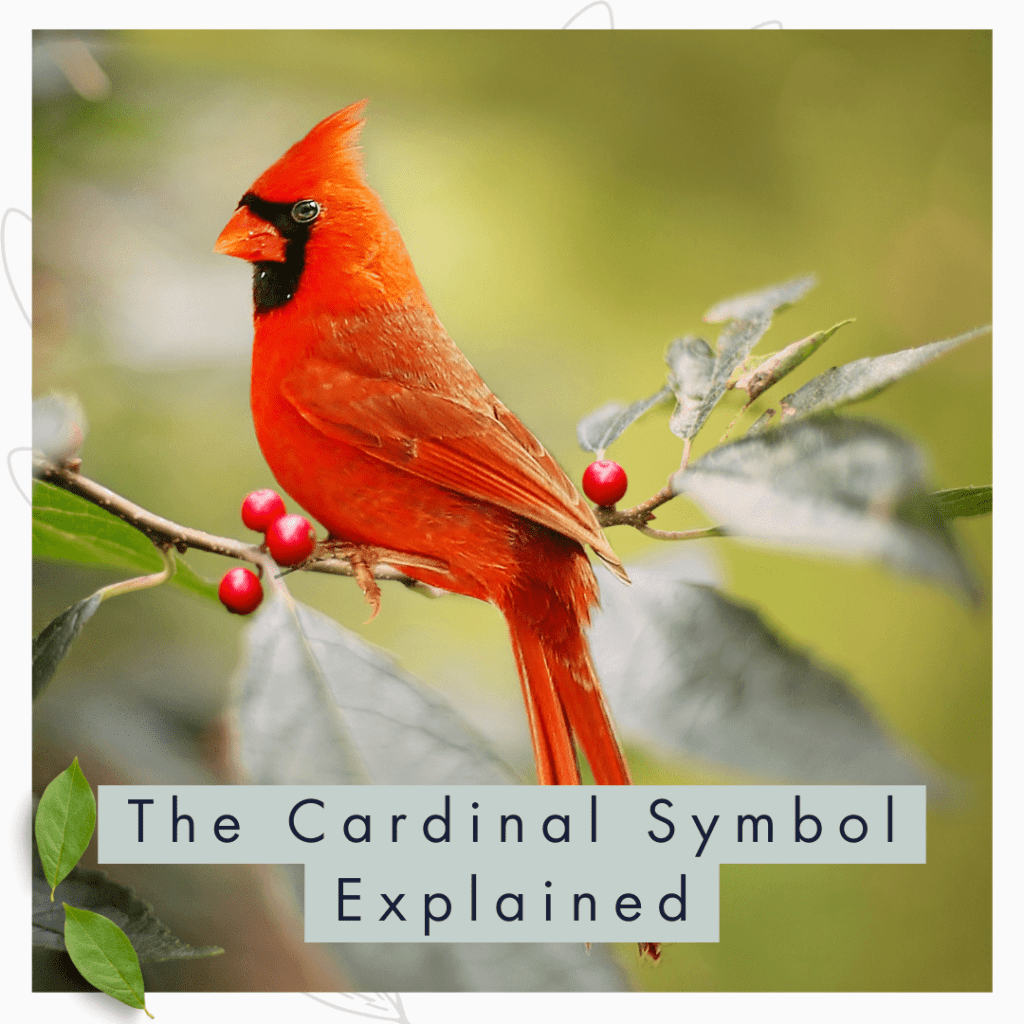The Cardinal Symbol Meaning

This post is about the cardinal symbol meaning.
- Introduction to the Cardinal Symbol
- The Northern Cardinal: A Snapshot
- Cardinal in Native American Culture
- The Spiritual Meaning of Cardinals
- Male and Female Cardinals: Differences and Symbolism
- Cardinals and Relationships
- Red Cardinals in Pop Culture
- Threats to the Cardinal Population
- Conclusion
- FAQs
Introduction to the Cardinal Symbol Meaning
The cardinal is a small bird with vibrant colors and a cheerful song. These beautiful birds hold a special place in the hearts of many in the Caribbean and worldwide. The bright red cardinal is honored in our Trinidadian family and we consider it a visit from a loved one.
Whether seen on power lines or bird feeders, the appearance of a cardinal is often regarded as a good sign. In this blog, we explore the symbolic meanings attached to this beautiful bird species and understand why it’s more than just a pretty sight.
The Northern Cardinal: A Snapshot
The Northern Cardinal, also known as the Cardinal, Redbird, or Common Cardinal, is a bird species found in North and South America. Its scientific name is "Cardinalis cardinalis."
The Northern Cardinal is best recognized for its bright red color, which is especially vibrant in male cardinals. The females, while not as brightly colored, still boast a beautiful reddish hue on their wings and tail feathers. Both sexes have a distinctive crest on their head and a mask on their face which is black in the male and gray in the female.
These birds are medium-sized and have a body length of 8.3–9.1 inches. They are songbirds, and both males and females sing. Their songs are a series of clear whistles with phrases that sound like "cheer cheer cheer," "whit-chew whit-chew" or "purty purty purty."
Northern Cardinals are non-migratory birds, meaning they do not migrate seasonally. They are commonly found in woodlands, gardens, shrublands, and swamps. They primarily feed on seeds, grains, fruits, and insects.
The Northern Cardinal is the state bird of seven U.S. states, more than any other bird. These states include Illinois, Indiana, Kentucky, North Carolina, Ohio, Virginia, and West Virginia. It is also an iconic sight during the holiday season, often depicted in snowy scenes on Christmas cards and ornaments.
Cardinal in Native American Culture
Native Americans have long admired the cardinal for its vibrant red feathers and strong spirit. In Native American folklore, the cardinal is regarded as a guardian angel, a bringer of good fortune, and a spiritual messenger. Different tribes attach different meanings to the cardinal, but its spiritual significance remains a common thread throughout.
In Cherokee culture, for example, the cardinal is referred to as "the daughter of the sun." The bird is seen as a carrier of news and messages, including news from the spirit world. Its bright red color is associated with the east direction and the rising sun, representing the start of a new day and renewal.
The Choctaw tribe has a slightly different interpretation. They associate the cardinal with relationships and believe that seeing a cardinal flying towards the sun is a sign of good luck.
Among the Hopi tribe, the cardinal direction South is represented by the color red, which is also the color of the cardinal bird. In this context, the cardinal is associated with the life force and vitality.
These interpretations are not universal among all Native American tribes. Each tribe has its own unique set of beliefs and traditions related to nature and wildlife. However, the cardinal, with its vivid color and distinctive song, is respected and admired among these diverse cultures.
The Spiritual Meaning of Cardinals
In the spiritual world, the cardinal is considered a power animal, a totem that guides and protects. The bright red bird is believed to connect the spiritual realm with real life, delivering messages from the spirit world. Seeing a cardinal is often interpreted as receiving spiritual guidance, a signal that you're on the right path, or even a visit from a deceased family member.
The cardinal holds deep spiritual significance in various cultures and religions. Here are some common interpretations:
- Messenger from the Spirit World: Many believe that the cardinal is a messenger from the spirit world, particularly a sign that a departed loved one is watching over you. Seeing a cardinal could be interpreted as their way of letting you know they're still with you.
- Symbol of Hope and Joy: The cardinal's bright red color and beautiful song often symbolize hope, joy, and renewal. This bird can bring a sense of positivity and rejuvenation to those who see it.
- Sign of Good Luck: In many cultures, spotting a cardinal is considered a sign of good luck. It might mean that positive changes or good news are on the horizon.
- Symbol of Endurance and Strength: Cardinals are known for staying in their territory year-round, even in harsh winters. This has made them a symbol of endurance, resilience, and strength.
- Representation of Life and Vitality: In Christianity, the red color of the cardinal is seen as representative of the living blood of Christ, symbolizing life and vitality.
- Reminder of Faith and Love: Some interpret seeing a cardinal as a reminder to keep faith during difficult times or as a symbol of the enduring nature of love.
Remember, the exact meaning can vary depending on personal beliefs, cultural backgrounds, and individual interpretation.
Male and Female Cardinals: Differences and Symbolism
In terms of spiritual symbolism, both male and female cardinals are generally seen as messengers or bearers of good news. They are associated with vitality, celebration, hope, and the presence of loved ones from the spirit world.
The male cardinal, with its vibrant red color, is often associated with boldness, passion, and energy. In Christianity, the red color of the male cardinal is seen as representative of the living blood of Christ.
On the other hand, female cardinals, which have a more subdued coloration (reddish-brown with bright red highlights), can symbolize grace, warmth, and subtlety. Their less conspicuous color is sometimes interpreted to represent inner strength and resilience.
It's important to remember that spirituality is a deeply personal experience, and the way one interprets signs and symbols can be unique to the individual.
Cardinals and Relationships
Cardinals also hold a romantic connotation. Some believe that seeing a cardinal can indicate the start of a new romantic relationship or the strengthening of an existing one. Additionally, the cardinal's association with home life and family members makes its sighting a positive message for our personal relationships.
Red Cardinals in Pop Culture
The red cardinal, with its striking plumage and melodious song, is not just a beloved feature of the natural world but also a prominent figure in pop culture. Here are a few examples:
- Literature: In Alexandre Dumas' classic novel, "The Three Musketeers," Cardinal Richelieu is one of the main antagonists. This character has been portrayed by notable actors such as Vincent Price, Charlton Heston, and Tim Curry in film adaptations.
- Christmas Decorations: The cardinal, also known as the 'red bird,' is a popular image in holiday decor. Its bright red color is often associated with the festive spirit of Christmas. During the holiday season, cardinals often find their way onto Christmas trees and holiday decorations. They symbolize the joy of new beginnings and are considered good omens for the year ahead.
- Music: The cardinal's name refers to the color of the male, which inspired someone to name it after the bright scarlet red worn by Catholic cardinals.
- Video Games: The cardinal even makes its way into video games, such as the Angry Birds franchise. The main character, Red, is based on a cardinal, and his image has been used on officially licensed merchandise like the "Nerdy Birdy" t-shirt.
- Folklore and Symbolism: In Native American folklore, where Northern cardinals are often called Redbirds, they are seen as messengers. Similarly, in Celtic culture, the red cardinal is considered a symbol of good luck.
From literature to video games, from holiday decorations to cultural symbolism, the red cardinal permeates various aspects of popular culture. It's a testament to the enduring appeal of this beautiful bird.
Threats to the Cardinal Population
Despite their spiritual importance, cardinals face threats from habitat loss. Bird feeders can provide them with necessary sustenance, but more comprehensive conservation efforts are needed to ensure their survival.
Cardinals are predominantly found across North America, from southern Canada through the eastern and central regions of the United States, extending south into Mexico and Central America. They thrive in a variety of environments, including woodland edges, overgrown fields, gardens, and shrublands.
Despite their adaptability, cardinals, like all wildlife, rely on certain conditions in their natural habitats. They need adequate food, shelter, and breeding sites, all of which are becoming increasingly scarce due to human activity.
Habitat loss is identified as one of the most significant threats to biodiversity worldwide. For cardinals, this primarily comes in two forms: deforestation and urban development.
Deforestation leads to the removal of trees and shrubs that cardinals use for nesting, shelter, and food sources. Urban development, on the other hand, replaces natural landscapes with concrete structures, roads, and manicured lawns, disrupting the cardinal's natural habitat and reducing available resources.
As habitats shrink and food sources become scarce, cardinals face increasing competition, not just amongst themselves, but also with other species. This can result in decreased reproduction rates and increased mortality.
Furthermore, habitat fragmentation – breaking up large, continuous habitats into smaller, isolated patches – can lead to isolated cardinal populations. This can reduce genetic diversity within populations and increase vulnerability to diseases and predators.
While the situation seems dire, it's not too late to help our feathered friends. Here are a few ways we can make a difference:
- Preservation and Restoration: Actively participating in or supporting initiatives that aim to preserve and restore natural habitats can make a significant impact. This includes reforestation efforts and the protection of existing green spaces.
- Creating Bird-Friendly Spaces: Even in urban environments, we can make a difference by creating bird-friendly spaces in our yards or balconies. Planting native trees and shrubs, providing bird feeders, and installing nesting boxes can all help.
- Supporting Sustainable Practices: Choose products from companies that commit to sustainable practices, including responsible sourcing of raw materials and minimal use of harmful chemicals.
- Raising Awareness: Educate others about the importance of biodiversity and the threats faced by wildlife like the cardinal. The more people know, the more they can contribute to the solution.
Conclusion
The next time you spot a cardinal, take a moment to appreciate not just its beauty but also its spiritual and symbolic meanings. As guardians from the spiritual realm and bearers of good fortune, these vibrant birds serve as reminders that we're never alone, even in our most difficult moments. So, let's do our part to protect them, for the sake of both our ecosystems and our spiritual beliefs.
FAQs
Q1: What does the cardinal symbolize?
A1: The cardinal symbolizes many things including hope, joy, health, rejuvenation, and celebration. In spiritual terms, they are often seen as messengers from the spirit world or as a sign that a departed loved one is watching over you.
Q2: Why is the cardinal considered a spiritual bird?
A2: The cardinal is considered a spiritual bird because it is believed to bridge the gap between our earthly world and the spiritual realm. Many cultures believe that seeing a cardinal can be a sign of good luck, a message from a departed loved one, or a symbol of resilience and endurance.
Q3: What does it mean when you see a cardinal?
A3: Seeing a cardinal is often interpreted as receiving a message or sign. This could be a reassurance that you're on the right path, a sign of good luck, or a visit from a deceased family member. It's also seen as a reminder to keep faith during tough times.
Q4: Is seeing a cardinal a good sign?
A4: Yes, in many cultures and religions, seeing a cardinal is considered a good sign. It's often interpreted as a message of reassurance, encouragement, or even a sign of good luck.
Q5: What is the significance of a cardinal in Native American culture?
A5: In Native American culture, the cardinal is seen as a messenger, carrying prayers to the spirit world. Different tribes have different beliefs, but generally, the cardinal is regarded as a guardian and a signal of good fortune.
Q6: What does a red cardinal symbolize in Christianity?
A6: In Christianity, the red cardinal is seen as a representative of the living blood of Christ. It also symbolizes everlasting vitality, as the color of the bird never fades.
Q7: What does it mean if a cardinal visits you in your dreams?
A7: If a cardinal visits you in your dreams, it's often seen as a good omen. It could indicate that good news is on the way or that you're being visited by a deceased loved one. It might also be a reminder to keep faith and stay strong.
Q8: What does it mean to see a female cardinal?
A8: Seeing a female cardinal carries the same general symbolism of hope, joy, and spiritual connection as seeing a male cardinal. However, because they are less common to see, some believe that spotting a female cardinal can represent grace and serenity.
Q9: Why are cardinals associated with Christmas?
A9: Cardinals are often associated with Christmas due to their vibrant red color, which matches the traditional Christmas color scheme. Additionally, their peak breeding season falls in winter, making them a common sight during the holiday season.
Q10: Are there any superstitions related to cardinals?
A10: Yes, there are many superstitions related to cardinals. One common belief is that if a cardinal crosses your path or visits your home, it's a sign of good luck or a visit from a deceased family member. Another is that seeing a cardinal can signify a change or end to a difficult period.
By Melissa Ramnauth, Esq. | This content is copyright of West Indian Diplomacy, LLC and may not be reproduced without permission.

She runs West Indian Diplomacy, a Caribbean blog aimed at promoting West Indian history and business in the global marketplace. Melissa has been an attorney for over 10 years. She currently focuses on trademark registration, trademark searches, and office actions. She also has extensive legal experience in the areas of trademarks, copyrights, contracts, and business formations. She owns her own Trademark Law Firm that is virtually based out of Fort Lauderdale.
This post was about the cardinal symbol meaning.
References:
Please Sign Our
Petition to Preserve Our Ship Records
By Submitting this Form
This page may contain affiliate links and ads at no extra charge to you. If you purchase something from these links and ads, West Indian Diplomacy may earn a small commission that goes towards maintaining the website and sharing our history.
Book Recommendations
The First East Indians to Trinidad: Captain Cubitt Sparkhall Rundle and the Fatel Rozack
History of the People of Trinidad and Tobago
An Introduction to the History of Trinidad and Tobago

Legal Disclaimer
Your use of the content on this site or content from our email list is at your own risk. The use of this website does not create an attorney-client relationship. West Indian Diplomacy does not guarantee any results from using this content and it is for educational purposes only. It is your responsibility to do your own research, consult, and obtain a professional for your medical, legal, financial, health, or other help that you may need for your situation.
The information on West Indian Diplomacy is “as is” and makes no representations or warranties, express or implied, with respect to the content provided on this website or on any third-party website which may be accessed by a link from this Web site, including any representations or warranties as to accuracy, timeliness, or completeness. West Indian Diplomacy will not be liable for any losses, injuries, or damages from the display or use of this information.
All information on this website is accurate and true to the best of West Indian Diplomacy's knowledge, but there may be omissions, errors or mistakes. West Indian Diplomacy is not liable for any damages due to any errors or omissions on the website, delay or denial of any products, failure of performance of any kind, interruption in the operation and your use of the website, website attacks including computer virus, hacking of information, and any other system failures or misuse of information or products.
As of this date, West Indian Diplomacy does not write sponsored posts or accept free products for review. All thoughts and opinions written by West Indian Diplomacy is our own.
West Indian Diplomacy welcomes comments on blog posts. All comments submitted to us are the opinions of the author and do not necessarily reflect or represent the views, policies, or positions of this site. We reserve the right to use our own discretion when determining whether or not to remove offensive comments or images.